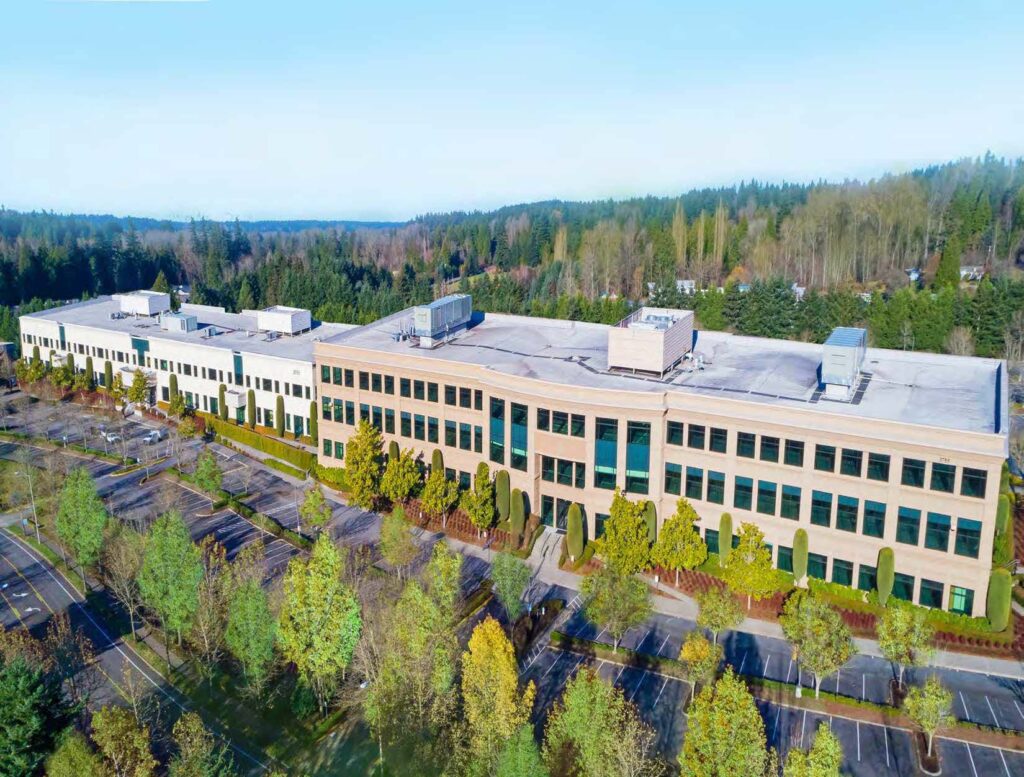REIT’s Q1 occupancy was steady at 94.6% and its project pipeline is 80% pre-leased
By Murray W. Wolf

One of the projects Alexandria completed during Q1 was 115,598 square feet at the Alexandria Center for Advanced Technologies – Monte Villa Parkway in Bothell, Wash. (Photo courtesy of Newmark)
PASADENA, Calif. – As perhaps evidence of a nascent recovery in the life sciences real estate (LSRE) sector, Alexandria Real Estate Equities Inc. (NYSE: ARE) reported strong first quarter (Q1) 2024 results Monday, April 22.
The Pasadena-based life sciences real estate investment trust (REIT) said that the occupancy rate for its existing properties held steady at 94.6 percent, new development deliveries totaled 343,445 square feet, and projects in its pipeline for the rest of 2024 and 2025 are 80 percent pre-leased.
‘Laser-focused on leasing’
On Tuesday, April 23, during the firm’s Q1 earnings conference call with securities analysts, Executive Chairman and Founder Joel Marcus said, “We are particularly laser-focused on leasing for the 2025 pipeline as well as redevelopment space to be delivered in 2025 and, of course, the leasing of vacant space in 2025, which is the fastest space to deliver to our growing tenants.”
He continued, “And much like we did during the Great Financial Crisis, we’re pushing forward our pipeline because of the need for Alexandria’s lab space, coupled with solid indicators of positive rebound for life sciences in 2024…”
Alexandria leased more than 1.14 million square feet of space during Q1, “consistent with our pre-pandemic velocity,” CEO and Chief Investment Officer Peter Moglia said during the earnings call. That included 994,770 square feet of renewals and re-leasing of space, and 100,232 square feet of leasing in newly developed or redeveloped space.
“In addition to the executed leases,” Mr. Moglia continued, “we signed 162,000 square feet of LOIs (letters of intent) during the quarter, which will see future development and redevelopment pipeline leasing.”
Rental rates for the newly leased space increased 33 percent, or 19 percent on a cash basis. However, Mr. Moglia said Alexandria doesn’t expect much near-term growth in rental rates due to the new space scheduled to deliver in the LSRE sector in 2024.
“We’re anticipating a very flat environment. Opportunities that Alexandria can provide in a mega campus are likely going to perform much better – materially better than some of the supply that’s going to be delivered,” he said, referring to the REIT’s concept of large multi-tenant developments in established life sciences clusters. “But, certainly, supply is going to weigh on rents… We expect 2024 to be the peak year for new deliveries and then begin to dissipate in 2025.”
Mr. Moglia added, “The bottom of demand was reached during the first half of 2023 and it continues to incrementally recover in our core markets. We expect that the lack of funding activity in early 2023 will continue to be an overhang to full recovery for a quarter or two, but we have strong conviction that a recovery will be achieved in the near-term” thanks to strong life sciences industry fundamentals.
Alexandria delivered five projects in Q1
On the development side, as noted above, Alexandria delivered 343,445 square feet during Q1, which Mr. Moglia said consisted of five projects in “our high-barrier-to-entry sub-markets.” The firm’s Q1 supplemental filing mentioned three of those projects:
■ 100,624 square feet at 500 N. Beacon St., located on The Arsenal on the Charles “mega campus” in Watertown, Mass.;
■ 115,598 square feet at the Alexandria Center for Advanced Technologies – Monte Villa Parkway in Bothell, Wash.; and
■ 72,846 square feet at 99 Coolidge Ave. in Cambridge, Mass.
In sum, Alexandria’s five newly delivered projects delivered incremental annual net operating income (NOI) of $26 million beginning in Q1 “and will drive future incremental annual net operating income aggregating $480 million” from Q2 2024 to Q4 2027, the firm said in its supplemental report.
“Annual net operating income (cash basis) is expected to increase by $101 million upon the burn-off of initial free rent from recently delivered projects,” the REIT said in its April 22 earnings news release, adding that initial free rent has a weighted-average “burn-off” period of about seven months.
As for specific geographic markets, Mr. Moglia noted that the direct vacancy rates as a whole were up 593 basis points to 12.98 percent in Greater Boston, up 175 basis points to 14.11 percent in the San Francisco Bay Area and up 244 basis points to 10.41 percent in San Diego. Sub-lease vacancy rates in those markets range from 5.17 to 6.28 percent.
“Again, 2024 is the peak year of disruption from supply,” Mr. Moglia reminded the analysts, noting that Alexandria’s 94.6 percent occupancy rate across its portfolio “is another data point supporting the effectiveness of our wide moat and enduring competitive advantages.”
Bullish on Boston, annoyed at New York
During the earnings call, Messrs. Moglia and Marcus also discussed Alexandria’s “asset recycling” program during the earnings call.
“After a busy fourth quarter 2023 schedule, where we closed on $439 million in asset sales marketed and negotiated throughout the year, we spent the first quarter priming our disposition and partial interest sales pipeline for what will likely be a closing schedule heavily weighted towards the third and four quarters,” Mr. Moglia said.
Thanks in part to that ongoing series of dispositions, the firm ended Q1 with $722.2 million of cash and cash equivalents, up from $618.2 million as of Dec 31, 2023, and had $6 billion of liquidity.
“Early progress (in additional dispositions) is reflected in pending transactions subject to letters of intent or purchase and sale agreement negotiations of $258.1 million, and there are a number of other ongoing active sales efforts,” Mr. Moglia said.
Mr. Marcus noted, “So that means we’re about 20 percent through our targeted $1.4 billion of recycling of capital for our business for 2024, and we feel very comfortable where we are today.”
Mr. Moglia continued, “Buyers of non-core assets are generally private equity, family office, local operators and institutionally backed real estate partnerships looking to diversify their asset mix with life science real estate.”
He added, “During the quarter, we closed on (the sales of) assets totaling $17.2 million,” including 99 A St. in Boston’s Seaport District, which sold for $13.5 million, “which executive management deemed to no longer be strategic due to its one-off profile and our pivot to 285, 299, 307, 347 Dorchester Ave., which is nearby with similar Red Line (subway) access, but has the scale to be a future mega campus.”
(Please see “Alexandria pays $155.3 million for a 60% interest in National Development project in Boston” for more information about that transaction.)
Mr. Moglia continued, “We remain committed to our self-funding strategy, and our offerings remain attractive to investors looking for exposure to life science real estate, given the promising outlook for the industry how we presented despite near-term supply challenges.”
Regarding Alexandria’s previously announced decision to sell the former 10-story, 350,000 square foot former Pfizer Inc. (NYSE: PFE) headquarters building at 219 E. 42nd St. in Midtown Manhattan, Mr. Marcus expressed frustration with New York city and state officials.
He said government officials are “continuing to incentivize and foster empty, one-off buildings for so-called life science use while turning their backs on fundraising of startup companies, which is the heart and soul of the New York City life science ecosystem and which is so badly needed.” He added there was “no lab leasing… whatsoever” in New York during Q1, “yet the state and the city are proposing fostering more and encouraging more people to deliver space.”
Mr. Marcus concluded, “We sit in a very good position with our campus but, nonetheless, when you have local and state governments who are not mindful of using funding better spent on funding startups and also the health, welfare and safety of the citizens, that’s very disconcerting.”
‘A fundamentally strong framework’
Those New York market frustrations aside, Hallie Kuhn, Alexandria’s senior VP of Science and Technology & Capital Markets, said during the earnings call that overall U.S. life sciences industry fundamentals are strong.
“In 2008, on the heels of the Great Financial Crisis, the size of the public biopharma industry was around $2.5 trillion and approximately $11 billion in venture capital (VC) was invested in private life science companies. There was no cure for hepatitis C, obesity was considered too complex to ever treat with an effective therapy, and gene and cell therapies were a hope, not a reality,” she said.
“Today, the industry is valued at over $5 trillion, venture capital is on pace to reach four times the levels deployed in 2008, 600 additional novel therapies have been approved by the FDA (U.S. Food and Drug Administration), and countless lives have been improved, extended and saved.
“Coming out of this bear cycle, albeit with stops and starts along the way, the life science industry is in a profoundly different place compared to previous cycles with a fundamentally strong framework to accelerate (the) long-term growth of the industry and demand for Alexandria lab space,” she said.
The REIT has a wide range of life sciences tenants including new and existing private and public biotech firms, multinational pharmaceutical companies, and providers of life science products, service and devices. Ms. Kuhn shared positive trends in each of those market segments that could bode well for tenants and Alexandria.
“First, with respect to life science venture investment, nearly $11 billion of deployed capital was announced in the first quarter, and $100 million-plus mega rounds accounted for 34 deals, the highest number in the last eight quarters and any quarter prior to 2021,” she said.
Other positive industry fundamentals, she said, include record-high follow-on and private investment in public equity (PIPE) investment and “robust” mergers and acquisitions (M&As) activity in the pharmaceuticals sector, “reflecting large pharma’s efforts to expand pipelines with innovative therapies.”
Ms. Kuhn also mentioned a couple of other notable trends, including that tenants focused on using artificial intelligence (AI) in the life sciences industry “have heavy equipment needs that require significant laboratory footprint,” and that pressure from the U.S. Congress to limit the use of Chinese contract development and manufacturing organizations (CDMOs) under the proposed BIOSECURE Act could benefit domestic CDMOs.
Most analysts consider Alexandria to be a ‘buy’
From an investor perspective, Alexandria reported Q1 2024 revenue of $769.11 million, up 9.8 percent from the same quarter last year, and in the neighborhood of what most analysts had estimated. Net earnings per share (EPS) came in at $2.35 during Q1, compared to $0.44 a year ago, and higher than most analysts had anticipated.
Alexandria’s stock closed at $116.59 yesterday, compared with $124.19 one month ago and $120.03 one year ago. Most securities analysts consider Alexandria to be a “buy,” according to Barron’s, with an average price target of $143.92 based on 13 ratings.
Although Alexandria specializes in LSRE, not mainstream office space, its total market capitalization of $34.4 billion at the end of Q1 technically made it the nation’s largest “office” REIT. It had an asset base of 74.1 million square feet, including 42.2 million square feet of operating properties, 5.3 million square feet of “Class A/A+” properties undergoing construction and one committed near-term project expected to commence construction in the next two years, 2.5 million square feet of “priority” anticipated development and redevelopment projects, and 24.1 million square feet of future development projects.
The full content of this article is only available to paid subscribers. If you are an active subscriber, please log in. To subscribe, please click here: SUBSCRIBE







